FOURTH LECTURE
Stuttgart, 26th December 1919.
My dear Friends,
I will begin by
placing before you what we may call the “Ur-phenomenon”
— primary phenomenon — of the Theory of Colour. By and
by, you will find it confirmed and reinforced in the phenomena you
can observe through the whole range of so-called optics or Theory of
Colour. Of course the phenomena get complicated; the simple
Ur-phenomenon is not always easy to recognize at once. But if you
take the trouble you will find it everywhere. The simple phenomenon
— expressed in Goethe's way, to begin with — is as
follows: When I look through darkness at something lighter, the light
object will appear modified by the darkness in the direction of the
light colours, i.e. in the direction of the red and yellowish tones.
If for example I look at anything luminous and, as we should call it,
white — at any whitish-shining light through a thick enough
plate which is in some way dim or cloudy, then what would seem to me
more or less white if I were looking at directly, will appear
yellowish or yellow-red (Figure
IVa).
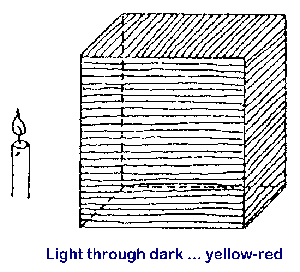
Figure IVa |
|
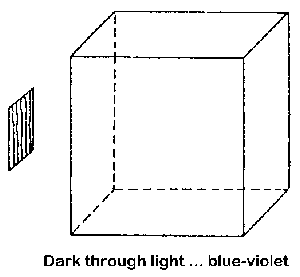
Figure IVb |
This is the one pole.
Conversely, if you have here a simple black surface and look at it
directly, you will see it black, but if you interpose a trough of
water through which you send a stream of light so that the liquid is
illumined, you will be looking at the dark through something light.
Blue or violet (bluish-red) tones of colour will appear (Figure
IVb). The other pole is thus revealed. This therefore is the
Ur-phenomenon: Light through dark — yellow; dark through light
— blue.
This simple phenomenon
can be seen on every hand if we once accustom ourselves to think more
realistically and not so abstractly as in modern science. Please now
recall from this point of view the experiment which we have done. We
sent a cylinder of light through a prism and so obtained a real scale
of colours, from violet to red; we caught it on a screen. I made a
drawing of the phenomenon (see
Figure IIc and
Figure IVc). You will remember; if this is the prism and this the
cylinder of light, the light in some way goes through the prism and
is diverted upward. Moreover, as we said before, it is not only
diverted. It would be simply diverted if a transparent body with
parallel faces were interposed. But we are putting a prism into the
path of the light — that is, a body with convergent faces. In
passing through the prism, the light gets darkened. The moment we
send the light through the prism we therefore have to do with two
things: first the simple light as it streams on, and then the dimness
interposed in the path of the light. Moreover this dimness, as we
said, puts itself into the path of the light in such a way that while
the light is mainly diverted upward, the dimming that arises, raying
upward as it does, shines also in the same direction into which the
light itself is diverted. That is to say, darkness rays into the
diverted light. Darkness is living, as it were, in the diverted
light, and by this means the bluish and violet shades are here
produced. But the darkness rays downward too, so, while the cylinder
of light is diverted upward, the darkness here rays downward and
works contrary to the diverted light but is no match for it. Here
therefore we may say: the original bright light, diverted as it is,
overwhelms and outdoes the darkness. We get the yellowish or
yellow-red colours.
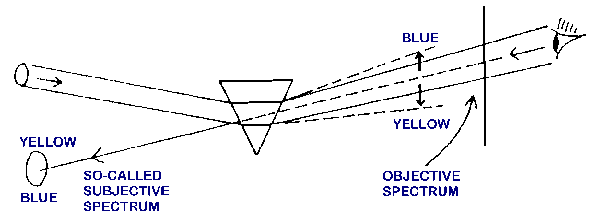
Figure IVc
If we now take a
sufficiently thin cylinder of light, we can also look in the
direction of it through the prism. Instead of looking from outside on
to a screen and seeing the picture projected there, we put our eye in
the place of this picture, and, looking through the prism, we then
see the aperture, through which the cylinder of light is produced,
displaced (Figure
IVc). Once again therefore adhering strictly to the facts, we
have the following phenomenon: Looking along here, I see what would
be coming directly towards me if the prism were not there, displaced
in a downward direction by the prism. At the same time I see it
coloured.
What then do you see
in this case? Watch what you see, state it simply and then connect it
with the fundamental fact we have just now been ascertaining. Then,
what you actually see will emerge in all detail. Only you must hold
to what is really seen. For if you are looking thus into the bright
cylinder of light — which, once again, is coming now towards
you — you see something light, namely the cylinder of light
itself, but you are seeing it through dark. (That there is something
darkened here, is clearly proved by the fact that blue arises in this
region). Through something darkened — through the blue colour,
in effect — you look at something light, namely at the
cylinder-of-light coming towards you. Through what is dark you look
at what is light; here therefore you should be seeing yellow or
yellowish-red — in a word, yellow and red, — as in fact
you do. Likewise the red colour below is proof that here is a region
irradiated with light. For as I said just now, the light here
over-whelms the dark. Thus as you look in this direction, however
bright the cylinder of light itself may be, you still see it through
an irradiation of light, in relation to which it is dark. Below,
therefore, you are looking at dark through light and you will see
blue or bluish-red. You need but express the primal phenomenon,
— it tells you what you actually see. Your eye is here
encountered by what you would be seeing in the other instance. Here
for example is the blue and you are looking through it; therefore the
light appears reddish. At the bottom edge you have a region that is
lighted up. However light the cylinder of light may be, you see it
through a space that is lit up. Thus you are seeing something darker
through an illumined space and so you see it blue. It is the polarity
that matters.
For the phenomenon we
studied first — that on the screen — you may use the name
“objective” colours if you wish to speak in learned
terms. This other one — the one you see in looking through the
prism — will then be called the “subjective”
spectrum. The “subjective” spectrum appears as an
inversion of the “objective”.
Concerning all these
phenomena there has been much intellectual speculation, my dear
Friends, in modern time. The phenomena have not merely been observed
and stated purely as phenomena, as we have been endeavouring to do.
There has been ever so much speculation about them; indeed, beginning
with the famous Newton, Science has gone to the utter-most extremes
in speculation. Newton, having first seen and been impressed by this
colour-spectrum, began to speculate as to the nature of light. Here
is the prism, said Newton; we let the white light in. The colours are
already there in the white light; the prism conjures them forth and
now they line up in formation. I have then dismembered the white
light into its constituents. Newton now imagined that to every colour
corresponds a kind of substance, so that seven colours altogether are
contained as specific substances in the light. Passing the light
through the prism is to Newton like a kind of chemical analysis,
whereby the light is separated into seven distinct substances. He
even tried to imagine which of the substances emit relatively larger
corpuscles — tiny spheres or pellets — and which smaller.
According to this conception the Sun sends us its light, we let it
into the room through a circular opening and it goes through in a
cylinder of light. This light however consists of ever so many
corpuscles — tiny little bodies. Striking the surface of the
prism they are diverted from their original course. Eventually they
bombard the screen. There then these tiny cannon-balls impinge. The
smaller ones fly farther up, the larger ones remain farther down. The
smallest are the violet, the largest are the red. So then the large
are separated from the small.
This idea that there
is a substance or that there are a number of substances flying
through space was seriously shaken before long by other physicists
— Huyghens, Young and others, — until at last the
physicists said to themselves: The theory of little corpuscular
cannon-balls starting from somewhere, projected through a refracting
medium or not as the case may be, arriving at the screen and there
producing a picture, or again finding their way into the eye and
giving rise in us to the phenomenon of red, etc., — this will
not do after all. They were eventually driven to this conclusion by
an experiment of Fresnel's, towards which some preliminary work had
however been done before, by the Jesuit Grimaldi among others.
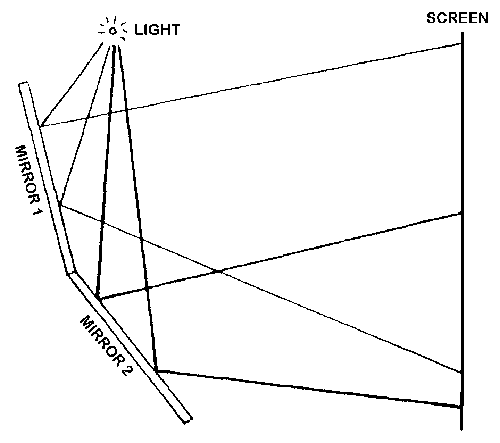
Figure IVd
Fresnel's experiment
shook the corpuscular theory very considerably. His experiments are
indeed most interesting, and we must try to get a clear idea of what
is really happening when experiments are set up in the way he did. I
beg you now, pay very careful attention to the pure facts; we want to
study such a phenomenon quite exactly. Suppose I have two mirrors and
a source of light — a flame for instance, shedding its light
from here (Figure
IVd). If I then put up a screen — say, here — I shall
get pictures by means of the one mirror and also pictures by means of
the other mirror. Such is the distribution you are to assume; I draw
it in cross-section. Here are two looking-glasses — plane
mirrors, set at a very small angle to one another, — here is a
source of light, I will call it L, and here a
screen. The light is reflected and falls on to the screen; so then I
can illumine the screen with the reflected light. For if I let the
light strike here, with the help of this mirror I can illumine this
part of the screen, making it lighter here than in the surrounding
region. Now I have here a second mirror, by which the light is
reflected a little differently. Part of the cone of light, as
reflected from here below (from the second mirror) on to the screen,
still falls into the upper part. The inclination of the two mirrors
is such that the screen is lighted up both by reflection from the
upper mirror and by reflection from the lower. It will then be as
though the screen were being illumined from two different places. Now
suppose a physicist, witnessing this experiment, were thinking in
Newton's way. He would argue: There is the source of light. It
bombards the first mirror, hurling its little cannon-balls in this
direction. After recoiling from the mirror they reach the screen and
light it up. Meanwhile, the others are recoiling from the lower
mirror, for many of them go in that direction also. It will be very
much lighter on the screen when there are two mirrors than when there
is only one. Therefore if I remove the second mirror the screen will
surely be less illumined by reflected light than when the two mirrors
are there. So would our physicist argue, although admittedly one
rather devastating thought might occur to him, for surely while these
little bodies are going on their way after reflection, the others are
on their downward journey (see the figure). Why then the latter
should not hit the former and drive them from their course, is
difficult to see. Nay, altogether, in the textbooks you will find the
prettiest accounts of what is happening according to the wave-theory,
but while these things are calculated very neatly, one cannot but
reflect that no one ever figures out, when one wave rushes
criss-cross through the other, how can this simply pass
unnoticed?
Now let us try to
grasp what happens in reality in this experiment. Suppose that this
is the one stream of light. It is thrown by reflection across here,
but now the other stream of light arrives here and encounters it,
— the phenomenon is undeniable. The two disturb each other. The
one wants to rush on; the other gets in the way and, in consequence,
extinguishes the light coming from the other side. In rushing through
it extinguishes the light. Here therefore on the screen we do not get
a lighting-up but in reality darkness is reflected across here. So we
here get an element of darkness (Figure
IVe). But now all this is not at rest, — it is in constant
movement. What has here been disturbed, goes on. Here, so to speak, a
hole has arisen in the light. The light rushed through; a hole was
made, appearing dark. And as an outcome of this “hole”,
the next body-of-light will go through all the more easily and
alongside the darkness you will have a patch of light so much the
lighter. The next thing to happen, one step further on, is that once
more a little cylinder of light from above impinges on a light place,
again extinguishes the latter, and so evokes another element of
darkness. And as the darkness in its turn has thus moved on another
step, here once again the light is able to get through more easily.
We get the pattern of a lattice, moving on from step to step. Turn by
turn, the light from above can get through and extinguishes the
other, producing darkness, once again, and this moves on from step to
step. Here then we must obtain an alternation of light and dark,
because the upper light goes through the lower and in so doing makes
a lattice work.
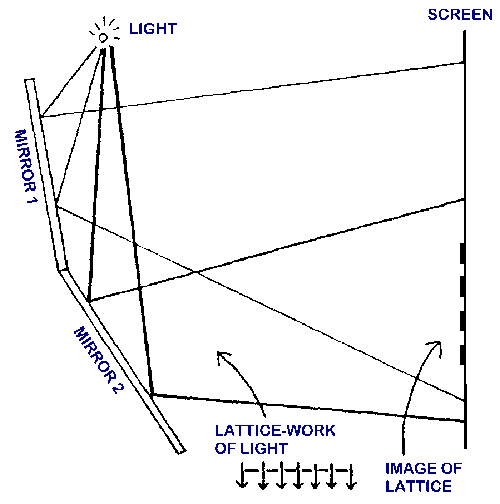
Figure IVe
This is what I was
asking you most thoroughly to think of; you should be able to follow
in your thought, how such a lattice arises. You will have alternating
patches of light and dark, inasmuch as light here rushes into light.
When one light rushes into another the light is cancelled —
turned to darkness. The fact that such a lattice arises is to be
explained by the particular arrangement we have made with these two
mirrors. The velocity of light — nay, altogether what arises
here by way of differences in velocity of light, — is not of
great significance. What I am trying to make clear is what here
arises within the light itself by means of this apparatus, so that a
lattice-work is reflected — light, dark, light, dark, and so
on.
Now yonder physicist
— Fresnel himself, in fact — argued as follows: If light
is a streaming of tiny corpuscular bodies, it goes without saying
that the more bodies are being hurled in a particular direction, the
lighter it must grow there, — or else one would have to assume
that the one corpuscle eats up the other! The simple theory of
corpuscular emanation will not explain this phenomenon of alternating
light and dark. We have just seen how it is really to be explained.
But it did not occur to the physicists to take the pure phenomenon as
such, which is what one should do. Instead, and by analogy with
certain other phenomena, they set to work to explain it in a
materialistic way. Bombarding little balls of matter would no longer
do. Therefore they said: Let us assume, not that the light is in
itself a stream of fine substances, but that it is a movement in a
very fine substantial medium — the “ether”. It is a
movement in the ether. And, to begin with, they imagined that light
is propagated through the ether in the same way as sound is through
air (Euler for instance thought of it thus). If I call forth a sound,
the sound is propagated through the air in such a way that if this is
the place where the sound is evoked, the air in the immediate
neighbourhood is, to begin with, compressed. Compressed air arises
here. Now the compressed air presses in its turn on the adjoining
air. It expands, momentarily producing in this neighbourhood a layer
of attenuated air. Through these successions of compression and
expansion, known as waves, we imagine sound to spread. To begin with,
they assumed that waves of this kind are also kindled in the ether.
However, there were phenomena at variance with this idea; so then
they said to themselves: Light is indeed an undulatory movement, but
the waves are of a different kind from those of sound. In sound there
is compression here, then comes attenuation, and all this moves on.
Such waves are “longitudinal”. For light, this notion
will not do. In light, the particles of ether must be moving at right
angles to the direction in which the light is being propagated. When,
therefore, what we call a “ray of light” is rushing
through the air — with a velocity, you will recall, of 300,000
kilometres a second — the tiny particles will always be
vibrating at right angles to the direction in which the light is
rushing. When this vibration gets into our eye, we perceive it.
Apply this to
Fresnel's experiment: we get the following idea. The movement of the
light is, once again, a vibration at right angles to the direction in
which the light is propagated. This ray, going towards the lower one
of the two mirrors, is vibrating, say, in this way and impinges here.
As I said before, the fact that wave-movements in many directions
will be going criss-cross through each other, is disregarded.
According to the physicists who think along these lines, they will in
no way disturb each other. Here however, at the screen in this
experiment, they do; or again, they reinforce each other. In effect,
what will happen here? When the train of waves arrives here, it may
well be that the one infinitesimal particle with its perpendicular
vibrations happens to be vibrating downward at the very moment when
the other is vibrating upward. Then they will cancel each other out
and darkness will arise at this place. Or if the two are vibrating
upward at the same moment, light will arise. Thus they explain, by
the vibrations of infinitesimal particles, what we were explaining
just now by the light itself. I was saying that we here get
alternations of light patches and dark. The so-called wave-theory of
light explains them on the assumption that light is a wave-movement
in the other [ether?]. If the infinitesimal particles are vibrating
so as to reinforce each other, a lighter patch will arise; if
contrary to one another, we get a darker patch.
You must realize what
a great difference there is between taking the phenomena purely as
they are — setting them forth, following them with our
understanding, remaining amid the phenomena themselves — and on
the other hand adding to them our own inventions. This movement of
the ether is after all a pure invention. Having once invented such a
notion we can of course make calculations about it, but that affords
no proof that it is really there. All that is purely kinematical or
phoronomical in these conceptions are merely thought by us, and so is
all the arithmetic. You see from this example: our fundamental way of
thought requires us so to explain the phenomena that they themselves
be the eventual explanation; they must contain their own explanation.
Please set great store by this. Mere spun-out theories and
theorizings are to be rejected. You can explain what you like by
adding things out of the blue, of which man has no knowledge. Of
course the waves might conceivably be there, and it might be that the
one swings upward when the other downward so that they cancel each
other out. But they have all been invented! What is there however
without question is this lattice, — this we see fully
reflected. It is to the light itself that we must look, if we desire
a genuine and not a spurious, explanation.
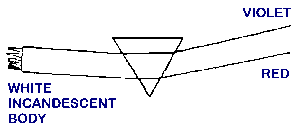
Figure IVf |
|
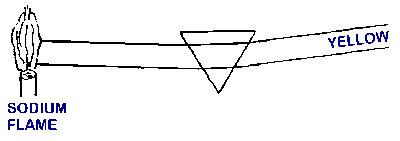
Figure IVg |
Now I was saying just
now: when the one light goes through the other, or enters into any
kind of relation to it, it may well have a dimming or even
extinguishing effect upon the other, just as the effect of the prism
is to dim the light. This is again brought out in the following
experiment, which we shall actually be doing, I will now make a
drawing of it. We may have what I shewed you yesterday — a
spectrum extending from violet to red — engendered directly by
the Sun. But we can also generate the spectrum in another way.
Instead of letting the Sun shine through an opening in the wall, we
make a solid body glow with heat, — incandescent (Figure
IVf). When we have by and by got it white-hot, it will also give
us such a spectrum. It does not matter if we get the spectrum from
the Sun or from an incandescent body.
Now we can also
generate a spectrum in a somewhat different way (Figure
IVg). Suppose this is a prism and this a sodium flame — a
flame in which the metal sodium is volatilizing. The sodium is turned
to gas; it burns and volatilizes. We make a spectrum of the sodium as
it volatilizes. Then a peculiar thing happens. Making a spectrum, not
from the Sun or from a glowing solid body but from a glowing gas, we
find one place in the spectrum strongly developed. For sodium light
it is in the yellow. Here will be red, orange, yellow, you will
remember. It is the yellow that is most strongly developed in the
spectrum of sodium. The rest of the spectrum is stunted —
hardly there at all. All this — from violet to yellow and then
again from yellow to red — is stunted. We seem to get a very
narrow bright yellow strip, or as is generally said, a yellow line.
Mark well, the yellow line also arises inasmuch as it is part of an
entire spectrum, only the rest of the spectrum in this case is
stunted, atrophied as it were.
From diverse bodies we
can make spectra of this kind appearing not as a proper spectrum but
in the form of bright, luminous lines. From this you see that
vice-versa, if we do not know what is in a flame and we make a
spectrum of it, we can conclude, if we get this yellow spectrum for
example, that there is sodium in the flame. So we can recognize which
of the metals is there.
But the remarkable
thing comes about when we combine the two experiments. We generate
this cylinder of light and the spectrum of it, while at the same time
we interpose the sodium flame, so that the glowing sodium somehow
unites with the cylinder of light (Figure
IVh). What happens then is very like what I was shewing you in
Fresnel's experiment. In the resulting spectrum you might expect the
yellow to appear extra strong, since it is there to begin with and
now the yellow of the sodium flame is added to it. But this is not
what happens. On the contrary, the yellow of the sodium flame
extinguishes the other
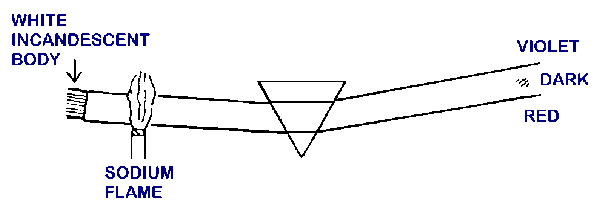
Figure IVh
yellow and you get a
dark place here. Precisely where you would expect a lighter part you
get a darker. Why is it so? It simply depends on the intensity of
force that is brought to bear. If the sodium light arising here were
selfless enough to let the kindred yellow light arising here it would
have to extinguish itself in so doing. This it does not do; it puts
itself in the way at the very place where the yellow should be coming
through. It is simply there, and though it is yellow itself, the
effect of it is not to intensify but to extinguish. As a real active
force, it puts itself in the way, even as an indifferent obstacle
might do; it gets in the way. This yellow part of the spectrum is
extinguished and a black strip is brought about instead. From this
again you see, we need only bear in mind what is actually there. The
flowing light itself gives us the explanation.
These are the things
which I would have you note. A physicist explaining things in
Newton's way would naturally argue: If I here have a piece of white
— say, a luminous strip — and I look at it through the
prism, it appears to me in such a way that I get a spectrum: red,
orange, yellow, green, blue, dark blue, violet (Figure
IVi). Goethe said: Well, at a pinch, that might do. If Nature
really is like that — if she has made the light composite
— we might well assume that with the help of the prism this
light gets analyzed into its several parts. Good and well; but now
the very same people who say the light consists of these seven
colours — so that the seven colours are parts or constituents
of the light — these same people allege that darkness is just
nothing, — is the mere absence of light. Yet if I leave a strip
black in the midst of white — if I have simple white paper with
a black strip in the middle and look at this through a prism, —
then too I find I get a rainbow, only the colours are now in a
different order (Figure
IVk), — mauve in the middle, and on the one side merging
into greenish-blue. I get a band of colours in a different order. On
the analysis-theory I ought now to say: then the black too is
analyzable and I should thus be admitting that darkness is more than
the mere absence of light. The darkness too would have to be
analyzable and would consist of seven colours. This, that he saw the
black band too in seven colours, only in a different order, —
this was what put Goethe off. And this again shews us how needful it
is simply to take the phenomena as we find them.
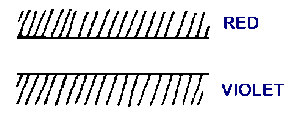
Figure IVi |
|
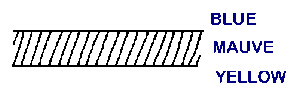
Figure IVk |
|